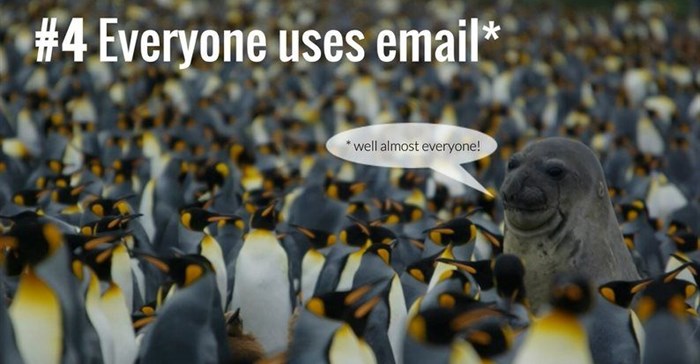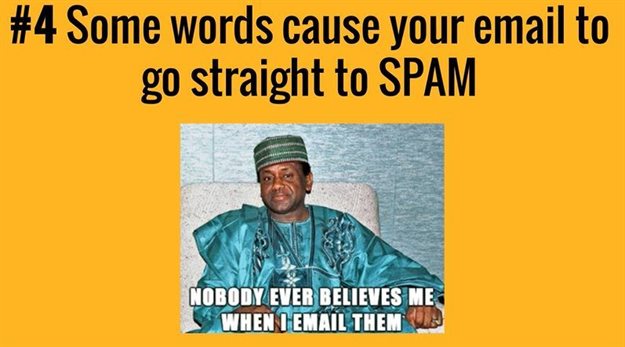
Philippa Dods, marketing manager for Meltwater Africa, started by pointing out that almost everyone uses email, from our colleagues to politicians.
In fact, a recent Hubspot survey revealed that 91% of consumers checking email inboxes daily, and 73% of all B2B businesses primarily communicating with their consumers using email.
That’s why it’s essential for brands to crack the email inbox, you’re golden. But between open-rates and click-throughs, spam folders and subscriber lists, how do we ensure we have a successful email marketing strategy in place, to show the most ROI?
That’s where Jason Bagley comes in. As CEO of Firing Squad specialist email marketing and lead-generation consultancy, he explained why email marketing is still effective today and debunked what he called five of his ‘favourite’ email marketing myths…
Bagley said while email marketing may not be the sexiest marketing platform, especially as it’s been around since the 1980s, it has definitely proven its staying power in the face of the current wave of Facebook ad campaigns and AI chatbots.
Some brands leave email marketing as an afterthought but do so at their peril as it remains a crucial part of successful digital marketing especially when integrated well with other marketing strategies like lead-generating offline activations, or even running a survey for brand awareness.

Bagley says wherever and whatever you’re doing with your digital marketing efforts, you should always be collecting email addresses to use that info later.
So it may well be the digital marketing dinosaur, but it’s by no means extinct as it’s immensely measurable and a consumer’s actions are trackable. You can monitor open rates and clicks, which help your brand to better understand your consumer and draw insights from the data they provide.
Email marketing also retains the highest ROI of all digital marketing channels. While the actual number changes from survey to survey, Bagley confirmed that email marketing continually comes out tops in offering the biggest bang for your marketing buck.
As an added bonus, that ‘bang’ is almost instant as you’re sending out to your list of leads or subscribers, and if it’s content they’re interested in, they’ll read it right away – you don’t have to wait six months for the SEO to kick in.
To up your email marketing ROI as much as possible, Bagley says to factor in permission practices as a double opt-in list results in higher ROI; as does preview testing, A/B testing of your message and segmenting your lists based on lead status, location or demographics.
This allows you to send targeted and indeed personalised emails, based on the needs and interests of your customer, which also leads to higher conversion rates.Next, Bagley unpacked today’s most common email marketing myths…
MYTH 1: The perfect day and time to send your newsletter
The first myth? That there’s one perfect day and time to send your newsletter – the good old Thursday at 10:30am or Tuesday at 2:50pm.
Bagley calls this ‘utter rubbish’.

Your own diary changes every single week, so sometimes you’re in a meeting or out and about at that time, not glued to your inbox. Others buck this trend and insist on sending their newsletters out of office hours, and as the content is what the receivers are looking forward to, they open the email.
So while there’s no silver bullet approach, Bagley has found the exception to the rule: People do come to expect your newsletter at a certain time.The Daily Maverick’s First Thing an example of this – it’s in your inbox before 6am so you can read it from home before you leave for the office, on your commute or as the first thing when you get to your desk.
For most businesses, the intention is to get people to open that newsletter. There’s no single perfect day or time for this, Bagley says to use common sense and test what works.
MYTH 2: The sbjct ||| shld b shrt
Bagley feels the belief that the email subject line should be as short as possible doesn’t always apply, either.
As marketers, we’re obsessed with keeping call-to-action copy on landing pages and lead-capture forms as short as possible.

Ultimately, the ideal email subject line length is 40 to 50 characters – even shorter on mobile, due to the email client’s ability to show the full subject line.
But sometimes, a slightly longer subject line is just what your brand needs to stands out from the inbox clutter as fewer messages are sent with longer subject lines.
As with everything, this is something to test in your own email newsletters. If shorter is more effective, stick with it. If longer is what gets your newsletter opened and clicked on, lengthen those subject lines (within reason, of course).
MYTH 3: ‘Unsubscribes’ are all bad news
Brands tend to brag about how long their email subscriber lists are and how fast they’re growing, but few will speak of how many unsubscribes they receive, as these are seen as a sign of something bad going on.
Bagley clarified that those ‘unsubscribe me’ requests come from people who don’t want to see your newsletter anymore.

Don’t fight this, let them go.
Businesses tend to make it difficult for people to unsubscribe by hiding the unsubscribe link, but unsubscribes are healthy as the smaller and cleaner your email subscriber list is, the more engaged your subscribers really are. So the people who are unsubscribing are most likely doing so as they don’t fit in with your ideal target market.They’re not interested in buying from you, they don’t want to receive your news – whether they specify that they’re unsubscribing because they’re moving on to a different company or not, respect that and get rid of the dead weight.
Bagley shared that Hubspot recently culled around 250,000 subscribers from their list, and found their engagement stats actually went up as a result as many of those recipients weren’t even opening the newsletter.
MYTH 4: Some words cause your email to go straight to spam
We’ve been trained to believe that certain keywords like ‘free’ shouldn’t be used in email subject lines.
But if you have something legitimately free to offer, there's no reason not to mention that right upfront.
Bagley says that again, it goes back to the quality of the list you’re sending to.

If it’s a clean list, there’s a better chance those recipients are actively looking out for your mails, opening them and clicking on the links. If you’re offering them something for free or a special deal, that’s even more of a win so make it clear!
MYTH 5: The more emails you send, the more you annoy your subscribers
Bagley says this is one of the questions he’s most frequently asked: How many emails should we be sending out? What’s a good number for frequency?
The answer depends on the specific content and special offers you’re sending out, but 5 to 8 emails/month seems to be the sweet spot – weekly or twice weekly is a good starting point.

It again ties back to the point that if the content you’re sending out is good quality, people will want to receive it. Some brands send out daily emails with huge readership and impressive open rates, others stick to a monthly newsy overview.
It all comes down to the expectations on your clients or subscribers, and balancing how often you have content to send them against how often they want to receive your news, so Bagley’s top tip is to listen to what your consumers want.
You can actively ask them, by including a survey on frequency, and noting reasons for unsubscribing – if ‘too many emails/too frequent’ comes up often, readjust your sending cycle.
At the end of the day, inbox success is about listening to what type of content your customers want to receive from you, then delivering that in the most appealing way.
After all, email is a proven revenue-driving machine. Bagley touched on a lot more than that, so click here to catch up on his ‘How to win at email marketing’ free Meltwater webinar.
